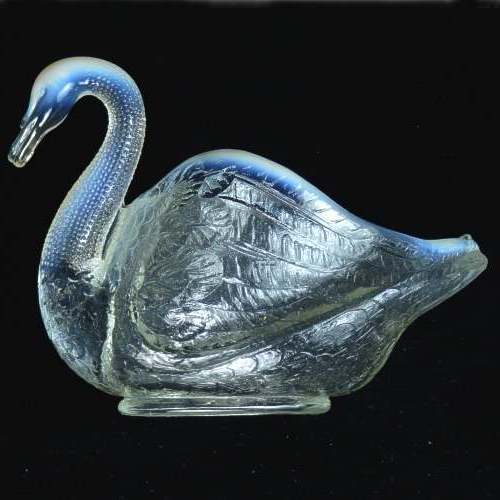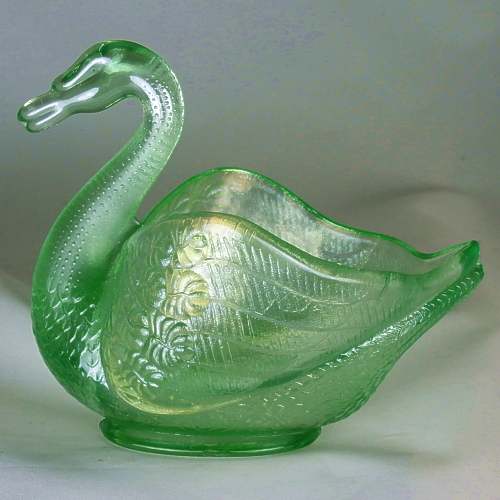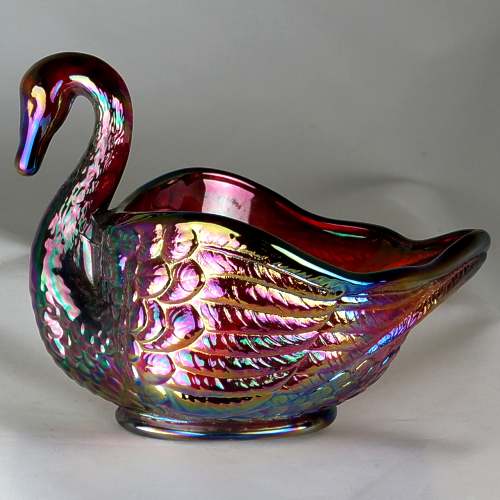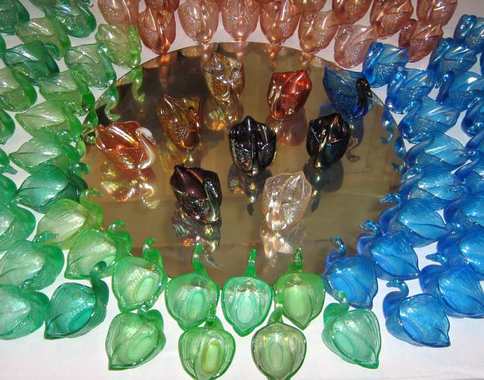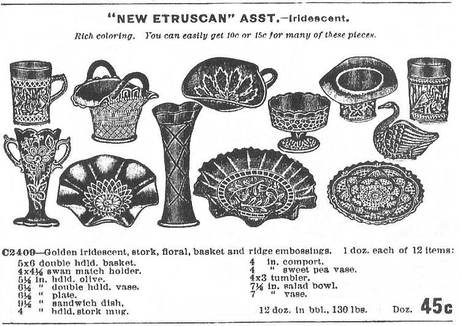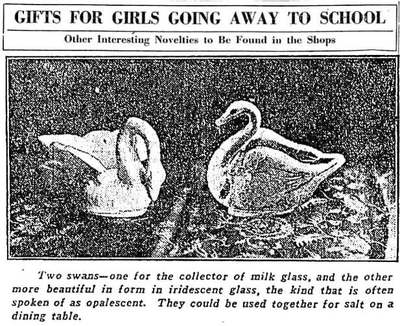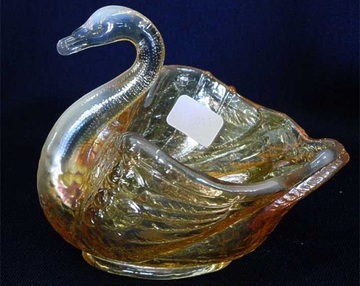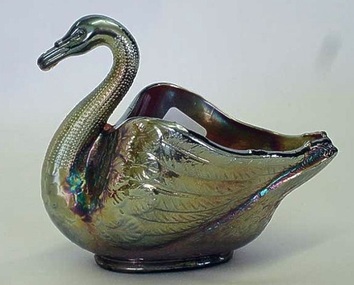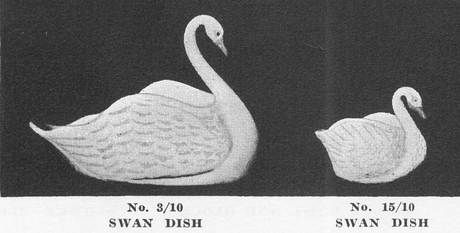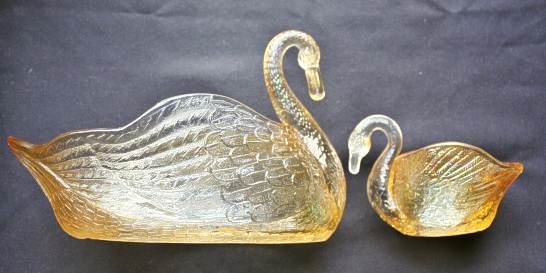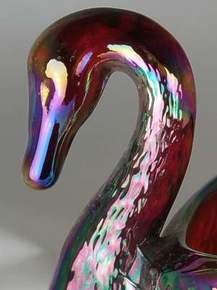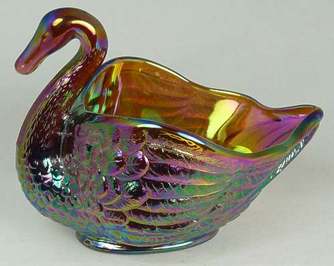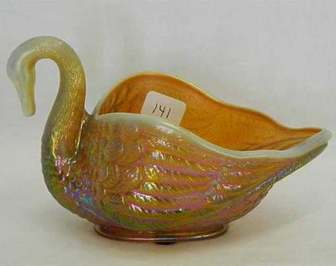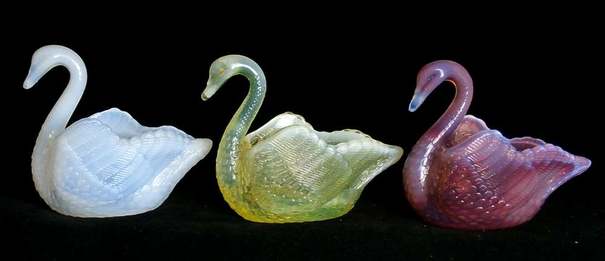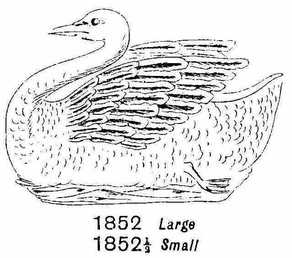Swanning Around!
Glass swans have been an enormously popular item for many, many years, and they are very collectable. Naturally, Carnival Glass makers did not want to miss out on a lucrative market, and open swans, or swan salts, were made in Classic Carnival Glass by Dugan, Dugan-Diamond and Fenton, and in contemporary Carnival Glass by Fenton and Imperial.
Here, we explore the "migration" of these glass swans from the master craftsmen of English glass in the 1800s, through to the equally talented and versatile Carnival Glass makers in the USA, and from Classic Carnival of the early 1900s to the contemporary revival of the 1960s/70s and later.
|
Classic Carnival Glass Swan salts
Lance and Pat Hilkene have amassed an amazing "flock" of Carnival Glass Swans, just some of which are pictured on the right. The total number in their collection is around 260, including ice green, teal, celeste and sapphire blue, purple, amethyst, vaseline, pink (in many shades), amber, white, marigold, and peach opal. Dugan is considered to have been the first to make Classic (old) Carnival Glass Swans, and Classic production continued with Dugan-Diamond and Fenton. Lance tells us that he believes these were the only makers of old swans in Carnival Glass. He explained: “The old Fenton swans are easy to distinguish by the definitive lines in the wings. The Dugan wings are more stylized and the wings have a more random look to them.” There’s no doubt that there are also other mould variations: the swan salts had a very long production run - the two images below show swans being offered in 1915 and in 1928. It seems almost inevitable that the moulds would have worn, requiring them to be re-cut, or even re-made entirely. Wm. Heacock ("Old Pattern Glass", 1981) stated that Northwood made swans in various non-Carnival opalescent colours and goofus, and it was Northwood's mould that was then used by Fenton (after 1920). However, we cannot confirm this. |
The feature in the Chicago Sunday Tribune is a fascinating insight - who would have thought that a requisite for "girls going away to school" would be gifts “for the departing student”? Some gifts are understandable - desk scissors, a book light and a tea set - but glass swans! Hardly the most practical of gifts. The swan shown on the right of the newspaper picture was described as being “in iridescent glass, the kind that is often spoken of as opalescent”. The misuse of opalescent (for iridescent) was not unusual and indeed it still persists today. It referred to a Carnival Glass Swan (sometimes called Pastel Swan or Swan Salt) which was made in a variety of colours in Classic Carnival by both Fenton and Dugan-Diamond.
Shown below are two relatively rare colours for Classic Carnival Swans, both pictures are courtesy of Seeck Auctions. On the left a Dugan (pre-Diamond) Swan in peach opal, and on the right a purple Swan which is probably Dugan-Diamond.
Shown below are two relatively rare colours for Classic Carnival Swans, both pictures are courtesy of Seeck Auctions. On the left a Dugan (pre-Diamond) Swan in peach opal, and on the right a purple Swan which is probably Dugan-Diamond.
L E Smith
Shown below left, is an extract from a L E Smith catalogue - the date is uncertain, between the 1930s into the 1950s. It shows two sizes of swans that were made by Smith in non-iridised crystal (clear), milk glass and black amethyst (and possibly other colours). On the right, below, is a picture of two marigold swans (courtesy of Jerry and Carol Curtis), which were probably made by Smith: the date they were made is also uncertain, but was probably the mid-1970s. We know that the small swan - 4.5" in size - was made in ice blue Carnival in 1978, as a limited edition of 1,000 (retaling at $7 each).
The "as moulded" swans faced straight forward, but many of them were manipulated by hand whilst the glass was still malleable, so that the neck and head turned to either left or right.
Contemporary Swans
When Carnival Glass was revived (from the 1960s/70s onwards), both Imperial and Fenton made swans in contemporary Carnival in a variety of colours. They were marked IG/LIG and Fenton respectively.
It should be easy to spot an Imperial swan as it has feathers instead of dots on its neck (as well as the Imperial trademark), as shown below left.
When Carnival Glass was revived (from the 1960s/70s onwards), both Imperial and Fenton made swans in contemporary Carnival in a variety of colours. They were marked IG/LIG and Fenton respectively.
It should be easy to spot an Imperial swan as it has feathers instead of dots on its neck (as well as the Imperial trademark), as shown below left.
The original inspiration
Were these pretty Carnival Glass swans inspired by another previous swan? We think so: our story about these pressed glass swans starts in England, well before the Classic Carnival Glass era.
We begin in 1874 (although it’s likely that even this is not the earliest example), with a very well-known English glassmaking name – Joseph Webb of Stourbridge. When he died in 1869, his executors Jane Webb and Joseph Hammond (his wife and brother in law) lodged a patent for a swan novelty for Webb’s Coalbourne Hill Glassworks. The Registered Design was number 288015: it was described as a frosted pressed glass swan planter / posy, that measured 4.7 inches long by 3.25 inches tall – a very rare item.
In 1885 Burtles and Tate in Manchester, England, registered a swan novelty. They are much sought-after items, and are known in clear (crystal) opalescent, rose pink opalescent and vaseline opalescent. Three sizes of swan are reported. The design was for a “glass flower holder”, and the Registered Design number is normally found moulded in a rectangle on the base (“Rd. No. 20086”). As the picture below shows, their design is extremely similar to the Carnival Glass Swans that were subsequently made by Dugan and Fenton in the USA.
Another famous English glassmaker got in on the act - Sowerby of Gateshead on Tyne registered designs for an open swan in 1890 and 1898 (above, right).
Master Glassmakers and their (Swan) connections
A fascinating part of glassmaking history is the way that master glassmakers, and their designs, moved from one factory to another, and even from one country to another. Carnival Glass enthusiasts will know full well that Carnival Glass makers Harry Northwood and brothers Tom and Alfred Dugan were English, learning their considerable glassmaking skills in the English glass industry before emigrating to the USA.
And now we can reveal another intriguing series of links.
Joseph Webb Jr. (son of Joseph Webb of Stourbridge) emigrated to the USA. There he was plant superintendent at Phoenix Glass Co., Indiana where he was understudied by Harry Northwood. Harry moved to the Indiana Glass Co., Dunkirk, Indiana where he was joined by Samuel Dugan and his sons Thomas E. A. Dugan, Alfred Dugan and Samuel Dugan Jr. Thomas and Alfred Dugan later set up the Dugan Glass Company.
Joseph Webb Jr. started a glassworks - Webb Decorative Glass Co. in Coudersport, Pennsylvania, which was later taken over by Harry Bastow. Harry Bastow employed Frank L. Fenton and his older brother John W. Fenton, who later left to form the Fenton Art Glass Company.
So there we have it. An open swan design starting life in England in the 1870s, moving across the Atlantic in the late 1800s and early 1900s, being adapted to Carnival Glass production by Dugan and by Fenton, and being reissued in the contemporary Carnival Glass revival by Fenton and Imperial.
That's quite a migration for a little swan!
Other Carnival Glass Swans/Swan motifs
As we said right at the start, swans were an enormously desirable shape and motif, so it is no surprise to find that Carnival Glass makers took advantage of their popularity. Here are some other Carnival Glass patterns featuring swans (with links to where you can see them on Carnival Glass Worldwide).
Australian Swan, Crown Crystal: Crown Crystal Gallery
Covered Swan, Sowerby: Sowerby Gallery
Nesting Swan, Millersburg: Millersburg Gallery
Royal Swans, Sowerby: Sowerby Gallery
Swan / Pastel Swan salt, Dugan-Diamond and Fenton
Swans and Flowers tumbler and vase, Jain, India
Contemporary:
Covered Swan, Mosser for Levay (old Westmoreland mould)
Seven Swans a Swimming, Christmas plate, Imperial: Collector plates
Swan (large) candy/novelty, Imperial
Swan candlestick, Fenton
Swan mug, Fenton (for Singleton Bailey)
Three Swans vase, contemporary Imperial.
